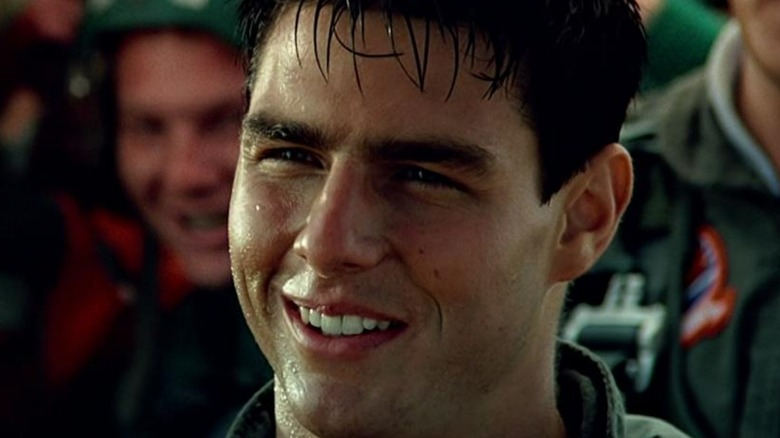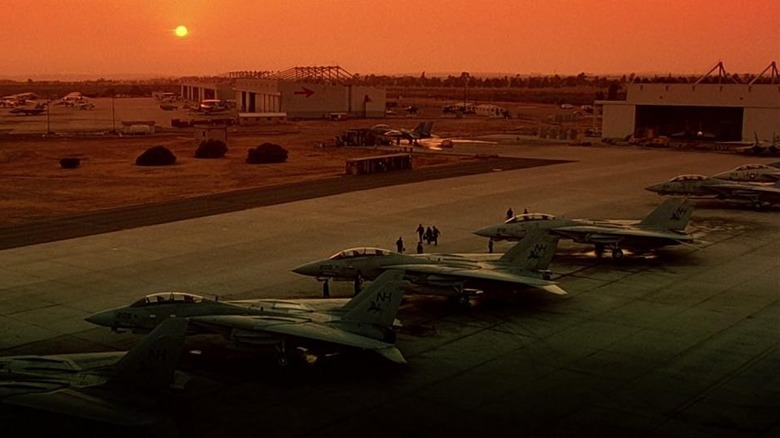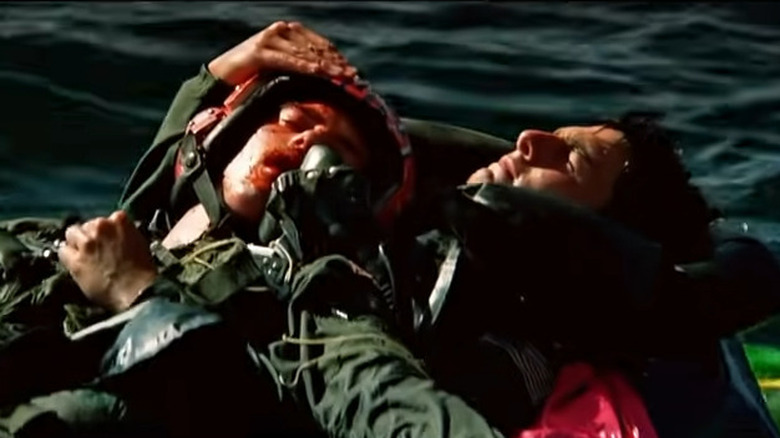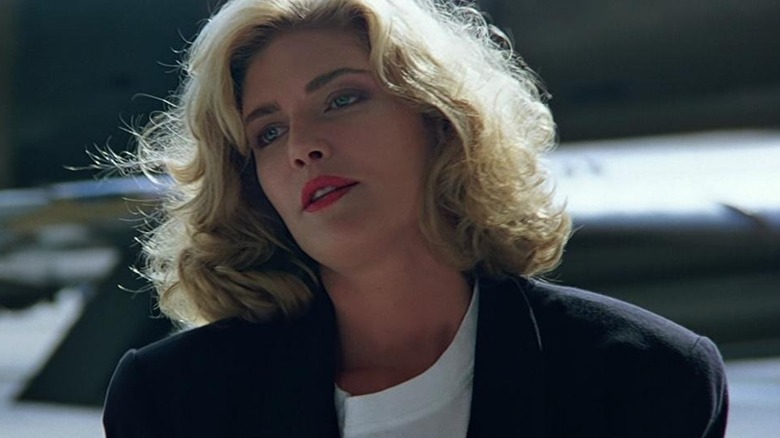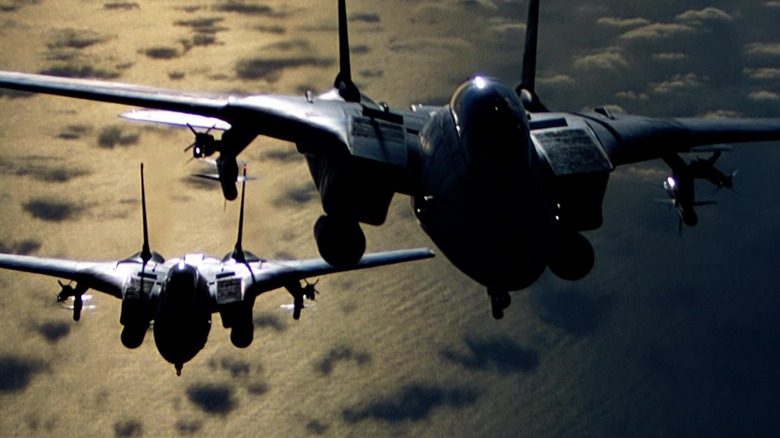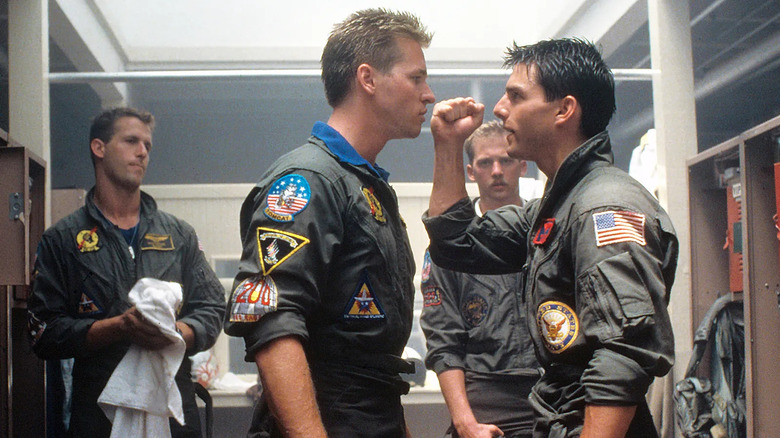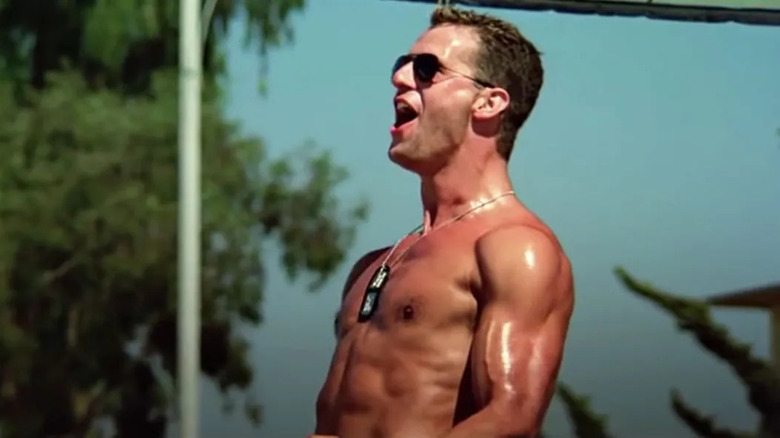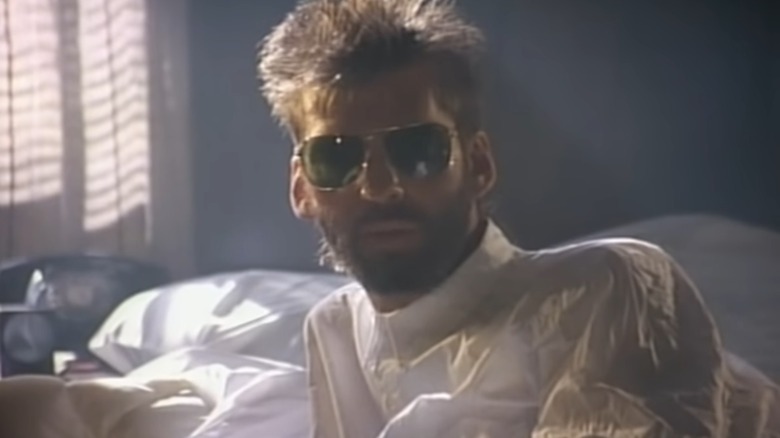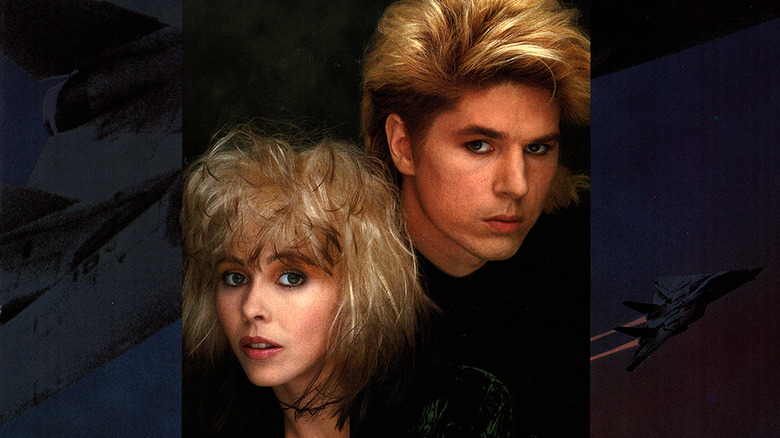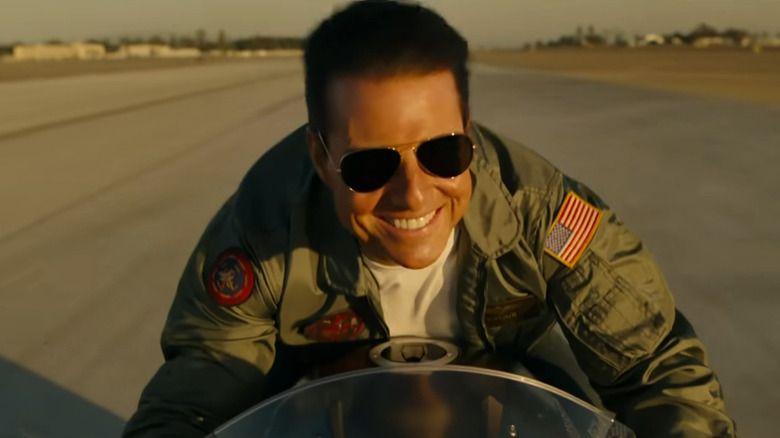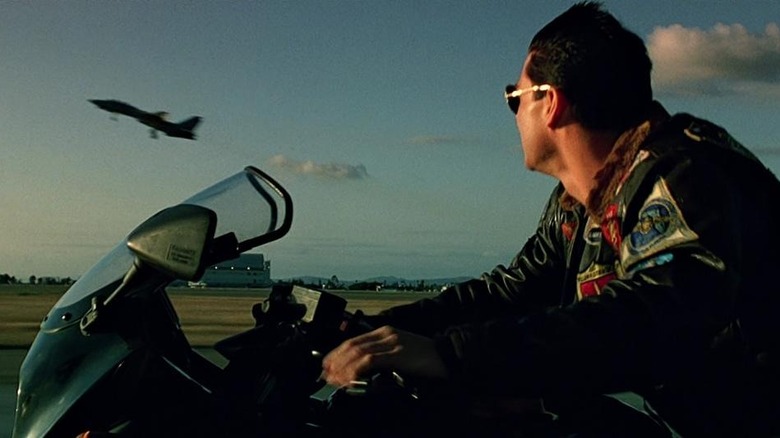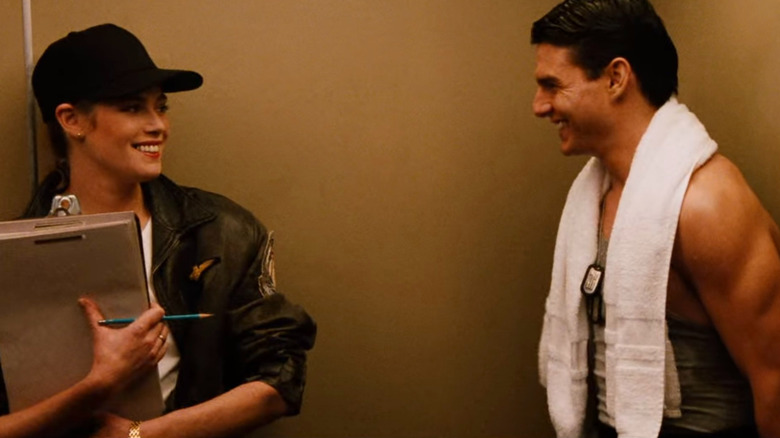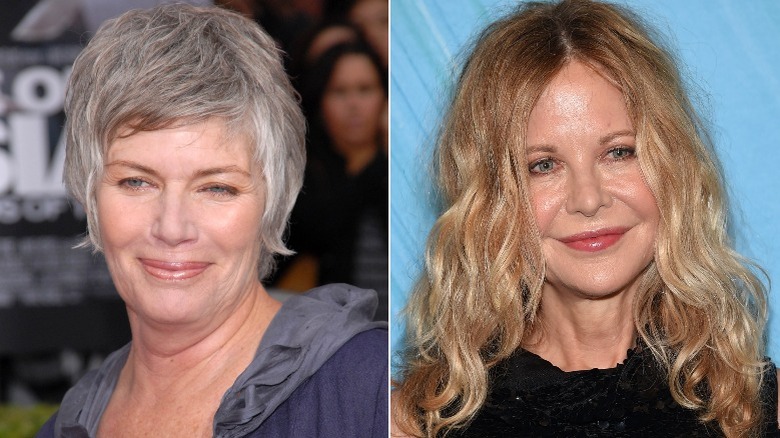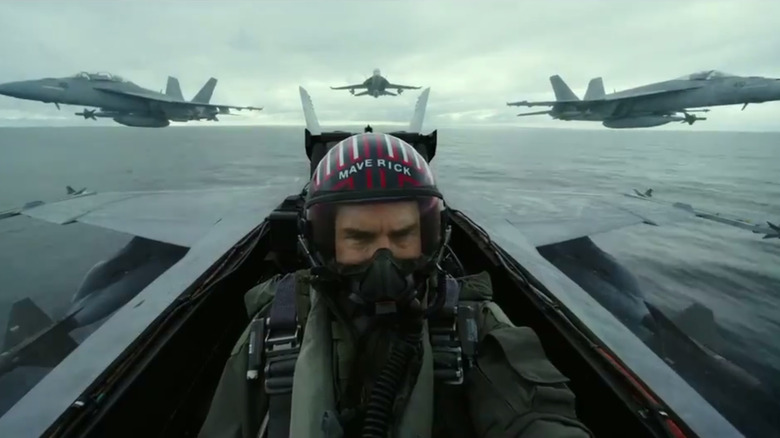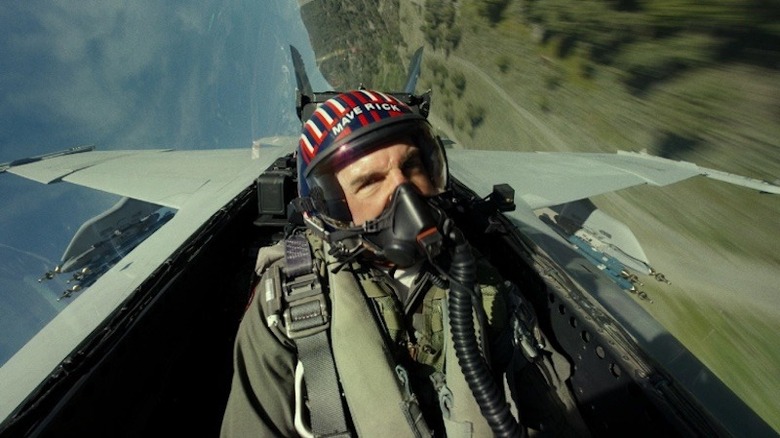The Untold Truth Of Top Gun
"Top Gun" is one of the most iconic films of the 1980s, making a mark with everything from its memorable soundtrack to its role in the development of Tom Cruise as one of Hollywood's most bankable movie stars. Inspired by a 1983 article in California Magazine, "Top Gun" is a fictional story based on life at the real US Naval Air Station Miramar in San Diego County, CA, which until 1996 was the home of the United States Navy Strike Fighter Tactics Instructor program, nicknamed TOPGUN. As in the film, TOPGUN was where the top 1% of US naval aviators were sent to train in the most advanced and intense aerial combat maneuvers, making it one of the most spectacular collections of piloting talent — and egos — in the world.
Using the California article and extensive on-base research as their guide, producers Jerry Bruckheimer and Don Simpson, director Tony Scott, and screenwriters Jim Cash and Jack Epps Jr. crafted the story of Lt. Pete "Maverick" Mitchell, a hotshot naval aviator who's driven to prove himself as the best pilot alive. Part military drama, part sports film, and part romance, "Top Gun" captured the attention of filmgoing audiences worldwide, and for better or worse, it launched a new era in the American war film. As with any movie this big, there's a lot of behind-the-scenes melodrama to explore, enough that even avid fans of the film might not know the whole story.
The US Navy was involved with Top Gun from the very beginning
It's no secret that "Top Gun" was produced in close cooperation with the United States Navy. Hollywood studios have collaborated with the United States Department of Defense since the birth of the movie business, but "Top Gun" is one of the most obvious products of that relationship. Most of the film was shot on location at Naval Air Station Miramar in California, home of the real-life TOPGUN program. According to Time, the production got to shoot using real F-14 Tomcats, four actual aircraft carriers, and some of the most skilled combat pilots in the world. The Navy offered access to these resources essentially at the cost of fuel and pilot hours, charging only $1.8 million total. (Top Gun's total budget was $15 million.)
What's less well-known is that the US Navy was involved in Top Gun before there was even a script. Producer Don Simpson had recently been involved in the production of 1982's "An Officer and a Gentleman," to which the US Navy refused access to facilities, costing the production millions. Simpson was determined not to have this happen on his next project, so he and Jerry Bruckheimer visited Navy headquarters in Washington to gauge their interest in a TOPGUN movie before even commissioning the screenplay. In fact, the duo hadn't worked out the story yet, and they had to improvise one on the spot. After receiving their enthusiastic approval, they worked closely with the Navy's Information Office throughout the production.
The Navy rewrote Goose's death
Securing the cooperation of the US Department of Defense (DoD) for a film involving the military can save a production millions of dollars, but it comes with strings attached. The DoD will only cooperate with productions that portray the military favorably and may aid recruiting efforts, and it will insist on revisions to the script in order to bring it in line with the image it wants to project. This can include omitting or revising historically accurate depictions that the Pentagon finds distasteful. Productions that refuse to make the required edits – such as Tom Cruise's military drama "Born on the Fourth of July" – must make do without those resources, which can significantly inflate their production costs.
Since "Top Gun" was written with pleasing the Navy in mind to begin with, the film's Navy-selected technical advisor and retired TOPGUN instructor Pete "Viper" Pettigrew had to request relatively few substantive changes to the script. Most of Pettigrew's revisions were in regard to the accuracy of the aerial combat maneuvers or life at Naval Air Station Miramar.
But one story change that the Navy insisted upon was the death of Nick "Goose" Bradshaw (Anthony Edwards), who would've perished as the result of a mid-air collision between two F-14s. According to the official documentary "Danger Zone: The Making of Top Gun," Pettigrew had to devise another realistic cause for Goose's deadly crash that would involve only one aircraft, which is the version that was filmed.
The real Charlie is a big deal
The romantic subplot of "Top Gun" went through a number of revisions during the writing process, with Maverick's romantic foil changing several times between drafts. According to the making-of documentary "Danger Zone," a later draft had a love story between Maverick and a Navy non-commissioned officer serving on base with him, but the real-life Miramar base commander refused to allow filming to commence unless this was changed, since fraternization within Naval ranks is against regulations. When Jerry Bruckheimer asked for plausible alternatives, the commander suggested a civilian instructor and analyst, introducing Bruckheimer to Christine Fox, a mathematician and civilian contractor with the Center for Naval Analyses.
According to People, Fox became the direct inspiration for Charlotte "Charlie" Blackwood, the romantic lead portrayed by Kelly McGillis. Like Charlie, Fox was an air superiority analyst who worked at Naval Air Station Miramar and took part in evaluating and training aviators in the TOPGUN program. Fox also socialized — though never romantically — with TOPGUN aviators at the Officer's Club, where Charlie first meets Maverick in the film. (Fox's opinion of the Righteous Brothers' "You've Lost That Lovin' Feeling" is not a matter of public record.)
In the decades following her assignment at Miramar, Christine Fox rose up the ranks at the US Department of Defense, and for a period of six months between 2013 and 2014, she served as acting deputy secretary of defense, becoming the highest-ranking woman in the history of the Pentagon.
Top Gun's flying is more dangerous than the real thing
Like any Hollywood movie, the commitment to accuracy in "Top Gun" has its limits. Some of the storytelling liberties are about creating character stakes — for instance, there is not, nor has there ever been, a TOPGUN trophy. The trophy is an invention of screenwriters Jim Cash and Jack Epps Jr., created to give Maverick and rival aviator Iceman (Val Kilmer) something to compete over, establishing sports-style stakes for a war film without a war. In the "Danger Zone" documentary, former TOPGUN instructor Pete Pettigrew recounts explaining to the screenwriters that if a trophy really existed, "No one would ever graduate. You don't understand the intensity of these guys ... Everybody would die."
Oddly enough, "Top Gun" did inspire more dangerous flying than would normally be conducted at Miramar, not because of competition but because of cinematography. As explained in "Danger Zone," the aerial combat maneuvers captured in the film were performed at closer range and at much lower altitude than normal. The lower altitude kept the nearby mountain range in frame, giving the aircraft a sense of speed that would be lost against a plain sky blue background. Planes flew far closer together than necessary for modern dogfighting, since using more realistic ranges would almost never allow two planes to be in frame at the same time, draining the scenes of any drama. TOPGUN's pilots were up to the task, but these maneuvers fell well outside their usual rules of engagement.
Val Kilmer didn't want to be in Top Gun
Val Kilmer's performance as Lt. Tom "Iceman" Kazansky is as memorable as Tom Cruise's Maverick, and it helped to transform him into a legitimate movie star. But according to his 2020 memoir "I'm Your Huckleberry," Kilmer had no interest in the role or in the script, and he only met with director Tony Scott out of pressure from his agent, who told him that Scott was "absolutely obsessed with [him]." Kilmer did everything he could to make a bad first impression at the meeting in the hopes of getting out of the gig, deliberately dressing awkwardly and sandbagging his line readings. It didn't work — Scott overwhelmed Kilmer with his enthusiasm for his acting and for the project, and Kilmer came on board.
The character of Iceman didn't give Kilmer a lot to work with, but he came up with a few ideas of his own to chew on — including the literal ice chips he's seen crunching in the film, an improvisation on this part. To give Iceman an inner life upon which to draw for his performance, Kilmer invented a Shakespearian backstory for Iceman, involving a cold and distant father who expected perfection from his son.
Kilmer changed his tune about "Top Gun" when he finally saw the film for the first time and saw how it all came together. Kilmer came to respect the work that went into making Top Gun into such a massive hit, and he recalls the experience fondly.
Rick Rossovich was booted off the Enterprise
According to the making-of documentary "Danger Zone," the beginning and ending of "Top Gun" were shot aboard the USS Enterprise (CVN-65), a fully manned and in-service nuclear aircraft carrier. Despite the presence of the film's cast and crew, normal operations continued aboard the Enterprise, to the extent that the cast wasn't allowed to know what the real Naval crew was up to or even the ship's exact location. For much of the film crew's five-day stay aboard the Enterprise, they simply shot the sailors and aviators going about their duties (though Tony Scott did essentially rent the Enterprise for about five mines— costing him $25,000 — to keep the captain from steering her out of ideal lighting).
During their stay, the cast and crew was allotted space in the crew quarters, and Rick Rossovich, who plays LTJG Ron "Slider" Kerner, was uncomfortable with his sleeping arrangements. Rossovich's bunk was positioned near a cautionary sign regarding the Enterprise's nuclear reactor, which spooked Rossovich into leaving his assigned area and crashing in someone else's. (In fact, Rossovich was in no danger of radiation exposure.) When the bunk's proper resident — an officer — arrived to find a Hollywood actor sleeping in his bed, Rossovich refused to vacate. Rossovich was sent to the captain for a talking to, which apparently didn't do the trick, as Rossovich's attitude got him choppered off of the ship a day ahead of the rest of the production.
Kenny Loggins lucked into singing 'Danger Zone'
The soundtrack album to "Top Gun" was a massive hit, going certified Platinum nine times over. Competition to participate in the soundtrack was fierce. Paramount set up a "cattle call," inviting established hitmakers to screen a rough cut of the film and indicating particular scenes in which they wanted to place music. Singer-songwriter Kenny Loggins, who'd already contributed a smash single for the film "Footloose," attended one such screening and was intimidated by the wealth of Top 40 talent in the room. Rather than try to go head to head with the other heavy hitters, Loggins and producer Peter Wolf chose, as Loggins puts it in the making-of documentary "Danger Zone," "the path of least resistance" and wrote a song for the scene they thought there would be the least competition for — the now-iconic beach volleyball scene.
The decision worked out better than he could've imagined. Standing out against the more than 300 submitted songs, Loggins' "Playing with the Boys" successfully won its place in the film. Not only that, but when negotiations fell through with several other Columbia Records artists to perform "Danger Zone," the song written by Giorgio Moroder and lyricist Tom Whitlock to close out the film, Loggins was approached at the 11th hour to record the lead vocal since he was already involved in the soundtrack. Loggins' "Danger Zone" would reach #2 on the Billboard charts and become one of the most iconic songs of the 1980s.
'Take My Breath Away' broke up Berlin
The biggest hit off the "Top Gun" soundtrack was "Take My Breath Away," written by Giorgio Moroder and Tom Whitlock and performed by American new wave band Berlin. Berlin, centered around singer Terri Nunn and songwriter John Crawford, was already an established major label act that had recently broken into the Billboard Top 20 with their 1984 single "No More Words," produced by Moroder. Having been impressed with Terri Nunn's vocals during their earlier session, Moroder invited Terri Nunn to record the vocals for "Take My Breath Away." Nunn jumped at the chance to record with Moroder again, but John Crawford was uneasy about the proposition of recording a high-profile song written by someone else.
Both Nunn's enthusiasm and Crawford's cynicism were vindicated. "Take My Breath Away" launched Berlin suddenly into the stratosphere, as the single reached #1 in six countries and won an Academy Award. The flipside of this good fortune was that the popularity of "Take My Breath Away" outshined all their previous recordings, and it became the definitive Berlin song to most audiences, which frustrated Crawford and other band members since they had little interest in a song they would now be expected to play at every show for as long as the band existed. This created a creative schism in the band that Nunn believes was the catalyst for their breakup in 1987.
Attempts at a Top Gun sequel stalled several times
"Top Gun" was the biggest box office hit of 1986, so it's no surprise that Paramount was interested in a sequel. First, Paramount considered a fast and cheap path to making "Top Gun II," reusing footage shot for the first film. In "Danger Zone: The Making of Top Gun," editor Billy Weber describes a phone call from a Paramount executive asking for him to provide all the unused airplane footage left over from the making of "Top Gun" for use in a hypothetical "Top Gun II." Weber explained that there was no leftover footage. The first film had included every usable frame of the hours of aerial combat maneuvers that were shot.
Navy Maj. David Georgi has also revealed (via Operation Hollywood) that Paramount pitched the Navy a "Top Gun" sequel in the early 1990s, and that this time, the Navy wasn't interested, as the criminal conduct of real TOPGUN aviators at a 1991 pilot convention had brought such public shame to the Navy that it led the secretary of the Navy to resign. According to Maj. Georgi, TOPGUN was "not something the Navy wanted to brag about" at the time.
Development on a sequel resumed in 2010, with plans to reunite producer Jerry Bruckheimer, director Tony Scott, and star Tom Cruise, but it stalled again after Scott's death in 2013. The eventual sequel, "Top Gun: Maverick," finally began shooting in 2018 with director Joseph Kosinski at the helm, once again utilizing real US Navy hardware.
After Top Gun, the military went Hollywood for good and vice versa
The impact of "Top Gun" can't be measured only in terms of its box office success. The release of "Top Gun" also correlated to a sizable boost in Navy recruitment, and these two factors combined led to a massive increase in the number of films being considered and approved to receive military assets in exchange for script approval. This trend has only increased. Hundreds films and television shows have been produced under this arrangement since "Top Gun," and as Hollywood studios have become more dependent on military support, the military has gained more leverage over studios to cave to their conditions. According to Mace Neufeld, producer of 1990's "The Hunt for Red October," the unwritten rule for Hollywood movies depicting the military is either get military cooperation "or forget about making the picture."
For Hollywood, cooperation with the Pentagon is an opportunity to show off stunning visuals of expensive military assets in their films and trailers without having to break the bank on props, sets, and CGI. For the Pentagon, cooperation with Hollywood is cheap advertising, the chance to curate a favorable impression of military service for generations of viewers. It's mutually profitable for the two entities — whether or not it's any good for the state of art or the viewing public is a matter for further debate.
Maverick and Charlie's biggest scenes were added later
"Top Gun" certainly is an action-drama before it's a romance, with Charlie and Maverick's love story riding shotgun. However, two of the duo's most memorable moments — the love scene and elevator scene — were added after filming wrapped. Kelly McGillis confirmed to Yahoo! Entertainment that something felt off during screenings of the movie, so she and Tom Cruise were called back to add the two scenes. WBUR reported that those in attendance at one of the screenings felt the couple's romance needed to play out more on screen.
McGillis also noted that she was well into production on another film — "Made in Heaven" — when these reshoots came around, and she was sporting an entirely different hairstyle and color. If you're wondering why that rather awkward love scene looks the way it does, it's because of the whole hair situation. The actor's silhouettes were used to hide McGillis's dark hair, and it's also why she's wearing a black baseball cap in the elevator scene.
Why Kelly McGillis and Meg Ryan weren't invited to the Top Gun: Maverick party
Kelly McGillis played a much more significant role in "Top Gun" than Meg Ryan, but both played important parts in the Navy flick. As such, it was somewhat shocking to hear neither woman was asked back to star in "Top Gun: Maverick." It's not just that they weren't asked back — they weren't even considered. Director Joseph Kosinski spoke with Insider about why McGillis and Ryan were never on his radar.
"Those weren't stories that we were throwing around," Kosinski told the outlet. The director seemed more focused on moving forward and not reflecting on the past. "I didn't want every storyline to always be looking backward," Kosinski said. "It was important to introduce some new characters." McGillis didn't seem too surprised about not being asked to participate and gave a straightforward response to Entertainment Tonight when the topic arose back in 2019. "I'm old, and I'm fat, and I look age-appropriate for what my age is. And that is not what that whole scene is about. To me, I'd much rather feel absolutely in my skin and who I am at my age as opposed to placing a value on all that other stuff," McGillis proclaimed.
Traning for Top Gun and Top: Gun Maverick was no joke
The original "Top Gun" training wasn't as intense as its sequel, but Tom Cruise noted on "The Graham Norton Show" that it wasn't easy. The actor was able to fly with the Blue Angels, and he had to experience hitting heavy Gs. He recalled at one point hitting 9.5 Gs, meaning you're being hit with nine and a half times your body weight while flying.
For the sequel, the training was put into the hands of Cruise himself — as if that would surprise anyone these days. The stunt master extraordinaire designed the entire program the actors would go through, according to Military.com. The training took about three months and included drills underwater, as aviators needed to be well-prepared in case they had to eject over an ocean. This was also crucial for the cast to learn, which Cruise confirmed to ET Canada, noting he and his co-stars went through ejector seat training, which he also confirmed he did for the original. The actors also had to feel the pressure of 7 Gs, which can be seen all over their faces in an incredible behind-the-scenes training video shared by Paramount Pictures.
Tom Cruise knew exactly what he wanted regarding effects in Top Gun and its sequel
In another interview on "The Graham Norton Show" before "Top Gun: Maverick" was confirmed, Tom Cruise revealed that one of his stipulations for the original was that he be filmed in the F-14 Tomcat. He said he made a deal with Paramount Pictures for this to happen, as that was the only footage he wanted to be used in the movie. If it weren't real, he simply wasn't interested.
For "Top Gun: Maverick," Cruise was adamant about there being no CGI in the film, relying solely on practical effects. When he and producer Jerry Bruckheimer caught up with Empire in 2020, Cruise hinted that he didn't want to do the film if they couldn't achieve everything they wanted without the help of CGI. "We just started talking," Cruise said of he and Bruckheimer's early discussions. "And I realized that there were things that we could accomplish cinematically. And I started getting excited about this big challenge of, 'How do we do it?' So I said to Jerry, 'I'll do it if...' meaning, I'm not going to do the CGI stuff."
Cruise and Bruckheimer were more than successful in their venture, with the former saying no movie has even been made like this before and probably never will be again.
